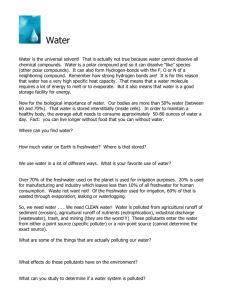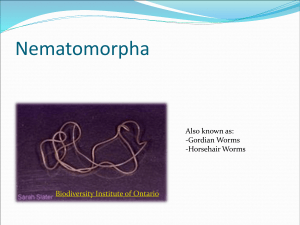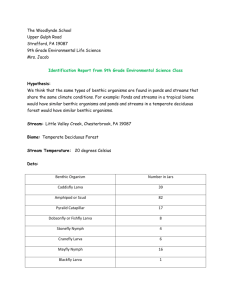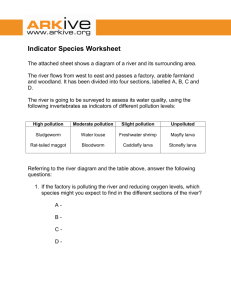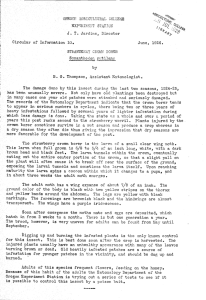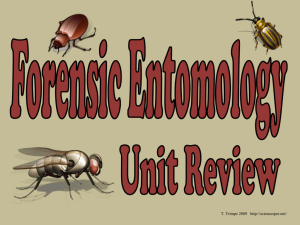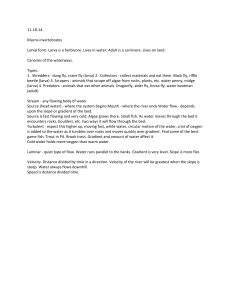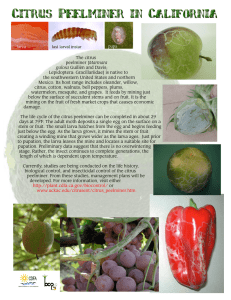AN ABSTRACT OF THE THESIS OF
advertisement
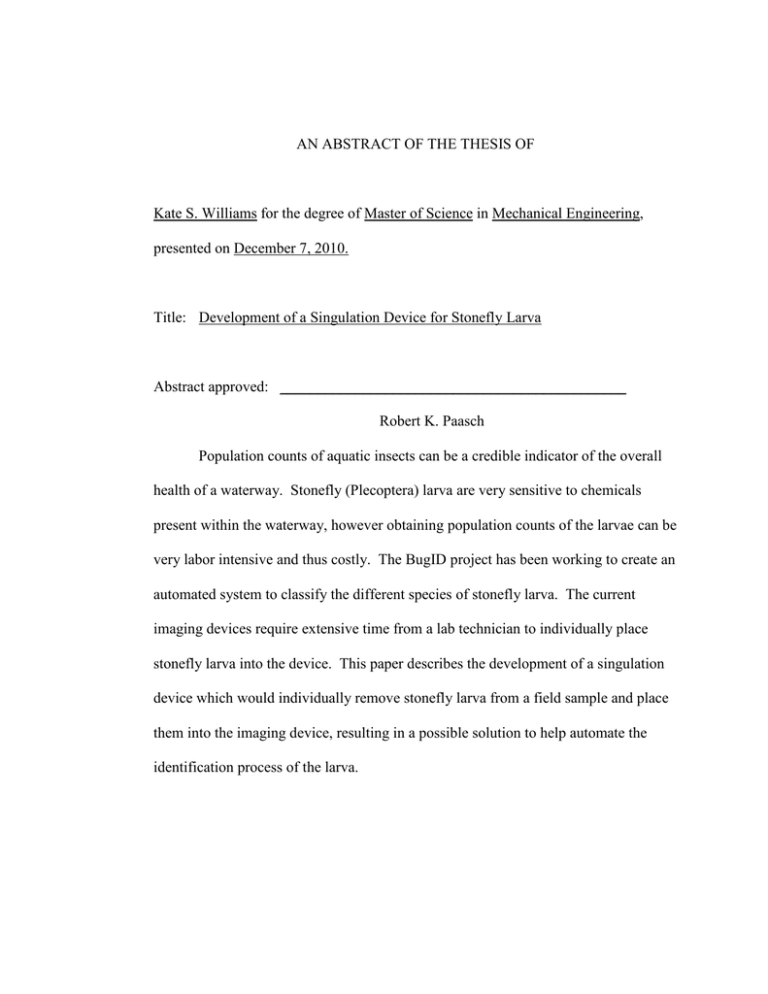
AN ABSTRACT OF THE THESIS OF Kate S. Williams for the degree of Master of Science in Mechanical Engineering, presented on December 7, 2010. Title: Development of a Singulation Device for Stonefly Larva Abstract approved: ______________________________________________ Robert K. Paasch Population counts of aquatic insects can be a credible indicator of the overall health of a waterway. Stonefly (Plecoptera) larva are very sensitive to chemicals present within the waterway, however obtaining population counts of the larvae can be very labor intensive and thus costly. The BugID project has been working to create an automated system to classify the different species of stonefly larva. The current imaging devices require extensive time from a lab technician to individually place stonefly larva into the device. This paper describes the development of a singulation device which would individually remove stonefly larva from a field sample and place them into the imaging device, resulting in a possible solution to help automate the identification process of the larva. © Copyright by Kate S. Williams December 7, 2010 All Rights Reserved Development of a Singulation Device for Stonefly Larva by Kate S. Williams A THESIS submitted to Oregon State University in partial fulfillment of the requirement for the degree of Master of Science Presented December 7, 2010 Commencement June 2011 Master of Science thesis of Kate S. Williams presented on December 7, 2010. APPROVED: Major Professor, representing Mechanical Engineering _ Head of the School of Mechanical, Industrial and Manufacturing Engineering Dean of the Graduate School I understand that my thesis will become part of the permanent collection of Oregon State University libraries. My signature below authorizes release of my thesis to any reader upon request. Kate S. Williams, Author ACKNOWLEDGEMENTS The first person that I would like to acknowledge is Dr. Robert K. Paasch for his guidance throughout the project. He was a great source of information throughout the process. I would also like to thank the other members of the BugID project for their contribution. Lastly, I would like to thank the National Science Foundation for the financial support it would not have been possible without their generosity. TABLE OF CONTENTS Page 1. Introduction…………………………………………………………….1 1.1 Current State of Project……………………………………….1 1.2 Mechanical Design Problem…………………………………..3 2. Background Literature………………………………………………….4 3. Design Process………………………………………………………….10 3.1. Customer Requirements………………………………………10 3.2. Engineering Specifications……………………………………12 4. Concept Generations……………………………………………………15 4.1. Proof of Concept – Prototype 1………………………………20 4.2. Prototype 2……………………………………………………22 5. Experimental Design………..………………………………………….25 6. Experimental Results……………………………………………………26 6.1. Results…………………………………………………………26 6.2. Discussion of Results………………………………………….30 6.3. Performance relative to Engineering Specifications…………..31 7. Conclusion and Future Recommendations ……………………………..34 8. References……………………………………………………………….37 LIST OF FIGURES Figure Page Figure 1: Process flow of stonefly larva through an automated………………2 Figure 2: Seed singulation components for a hopper. Seeds are individually removed from the hopper and travel down the seed tube to the furrow bottom. The furrow closer then places soil on top of the seeds in the furrow (figure provided by Moody et. al. (2003))……………………………………………….6 Figure 3: Grain kernel singulation device created by Melvin et. al. (2003). et. Al. (2003)…………………………………………………………..9 Figure 4: First concept generated, stonefly larva are placed in the holding container and then using a pump moved down the channel. The brush in the channel is used to de-tangle the stonefly larva……………………………………………………..…..16 Figure 5: Second concept generated, the left figure is the side view and the right is a top view. The stonefly larva are placed in the holding container and drop into the holes in the disc when the disc is positioned below the container…………………….….…..17 Figure 6: Third concept generated, a vibrating table with different sized holes at the end where single stonefly larva will drop thru...…18 Figure 7: Fourth concept generated, where a 6-axis robot is used to remove stonefly larva from a basin…………………………………..18 Figure 8: Fifth concept generated, left showing an isometric view of the concept and the right showing a side view……………………19 Figure 9: Prototype 11………………………………………………………..21 Figure 10: A stonefly lodged into the disc with the ¼ inch extension added to the hole……………………………………………………..22 Figure 11: SolidWorks model of Prototype 2………………………………..23 Figure 12: Prototype 2…………………………………………………….….23 Figure 13: Prototype 2 showing the curvature of the bottom of the main basin main basin…………………………………………………………….24 Figure 14: The amount of occurring trials for the number…………………….27 Figure 15: Two Stonefly Larva being Extracted……………………………..27 Figure 16: Stonefly Larva Singulated with a Sideways Orientation………….28 Figure 17: Stonefly Larva Singulated with a Tail First Orientation…………..29 LIST OF TABLES Table Page Table 1: Customer Requirements for the singulaiton device…………………10 Table 2: Engineering Specifications for singulation device…………….……12 Table 3: House of Quality…………………………………………………….13 Table 3: Orientation of successfully singulated stonefly larva……………….28 Table 4: Time it takes to extract stonefly larva……………………………….30 Table 5: Average times to dislodge stonefly larva……………………………30 Table 6: Engineering Specifications compared to the measured value from the singulation device…………………………………….32 1 1. Introduction Stonefly (Plecoptera) larva are very sensitive to changes in the chemicals within water. This characteristic makes them an accurate indicator of the health of an ecosystem. The BugID project at Oregon State University is working to automate the identification of stonefly larva, in order to make it possible to easily analyze the health of streams. There are two major parts to the project: 1) creating a fully automated system that singulates, images, and sorts the stonefly larva, and 2) developing pattern recognition software that classifies the species from the images obtained from the imaging system (Sarpola et. al., 2008). The objective of this thesis is to conceptualize, design, develop and test a proof of concept of a singulation device that removes a single stonefly larva from a population and places the individual specimen into an imaging tube without damaging the specimen. This is only going to be proof of concept device because of limitations on time and funding available. 1.1 Current State of Project There are five functions to a fully automated system for identifying stonefly larva: singulation, orientation, imaging, identification and sorting. Figure 1 shows the process flow of stonefly larva through the system. The desired result is the input into the identification system of a large volume of stonefly larva and the positive identification and sorting by taxa. The stonefly larva specimens must be kept in a liquid solution of 70% ethanol and 30% water. If the specimens are out of the solution they dry up 2 and curl into an unnatural position and break easily. So the stonefly larva specimens must be kept in the ethanol and water solution at all times, causing the handling of the stonefly larva to be complex. Figure 1: Process flow of stonefly larva through an automated identification system The first process needed in the automated identification system is a singulation device. The objective of the singulation device is to remove a single stonefly larva from a batch of specimens. Once the stonefly larva are individually removed they need to be placed into the imaging device. Once the stonefly larva have been singulated, they need to be correctly oriented so they can be imaged. The desired orientation of the stonefly larva for imaging is a dorsal view. Previous work by Thomas (2006) showed that stonefly larva will land on their backs 97.5 to 99.2 percent of the time when dropped thru the ethanol and water solution, depending on the width of the tube they are dropped in. The current imaging device performs both the orientation and imaging of the stonefly larva. The current imaging device utilizes this by having the stonefly larva drop through ethanol two inches and a camera is mounted below to capture images. 3 After the stonefly larva has been imaged, pattern recognition software is used to classify the stonefly larva by taxa. The development of this identification software has been an ongoing process since the beginning of the project. Detailed information about the pattern recognition software and method is available in previously published work by the group (Deng et. al., 2007; Larios et. al., 2007; Mortensen et. al, 2005; Mortensen et. al., 2007; Zhang et. al., 2006). A sorting device is desired for sorting the identified stonefly larva into separate compartments of taxa. There has been previous work done on developing a sorting device and a proof of concept proved that it would be possible to create such a device. All of the components needed to accomplish the functions necessary to fully automate the identification process of stonefly larva have been created except the singulation device. It is important to create a device that singulates stonefly larva in order to fully automate the process. 1.2 Mechanical Design Problem There were many challenges to creating the singulation device; tangling of stonefly larva with one another, large range of size of larva, and the different species of stonefly larva. 4 Stonefly larva live in streams and cling to rocks and debris within the stream. This causes stonefly larva to have a tendency to cling to one another making separating them by hand difficult. Stonefly larva come in a large range of sizes. The stonefly larva that have been imaged with the current device range from about an 3 mm to about 38 mm in length, while the widths have ranged from about 1 to 10 mm. In an attempt to simplify the design problem, there will be a limited size of larva for the creation of the singulation device. There are many different species of stonefly larva in the world, and all of them react differently to handling. Creating a singulation device that could be used with all stonefly larva is desired. In order to create such a device to singulate all species of stonefly larva would require extensive testing. Time was limited for this project. To reduce the amount of testing a single stonefly larva will be used. 2. Background Literature Through performing background research on singulation devices not much information was found on insect singulation devices. Most prior work in singulation is focused on agricultural products. Previous work at New Mexico State University by the Integrated Biological Control Team developed a system for identifying and sorting insects found in crops and fields (Drake (2008)). The insects of interest are on that are harmful or beneficial 5 in the food and agricultural industry. The team developed a system where a 6-axis robot would go in and use a vacuum to suction the insect to the end of the robot arm and then identify and sort by moving the insect with the robot arm. Previous work done on the BugID project at Oregon State University included developing a mechanical system for imaging and sorting of soil mesofauna. The sorting function was performed by using a 6-axis robot to remove soil mesofauna out of a petri dish containing a glycol and glycerin solution (Chamblin (2008)). Singulation devices are already widely used within agriculture. The most common singulation devices in agriculture are used to remove single seeds from a seed hopper and place them individually into furrows. Generally seed singulation consists of four major components as shown in Figure 2. Seeds are held in the seed hopper and are removed from the hopper one at a time with the metering device, a circular plate with holes which removes one seed at a time from the hopper to the seed tube and transfers it into the furrow bottom. A furrow closer then places soil on top of the seeds (Moody et. al. (2003)). 6 Figure 2: Seed singulation components for a hopper. Seeds are individually removed from the hopper and travel down the seed tube to the furrow bottom. The furrow closer then places soil on top of the seeds in the furrow (figure provided by Moody et. al. (2003)). Gel encapsulated propagules are uniform spheres cons consisting isting of 90% water. It is easier to singulate these capsules when they are placed in water since air-born air capsules have a tendency to stick to one another. Gautz et. al. (1989) designed and tested a capsule singulation device which keeps the gel capsule capsuless in water inside the hopper. The metering plate had 40 2mm diameter holes equally spaced which removed the capsules from the hopper hopper. A flow of air is used to dislodge the capsules from the metering plate and down the drop tube to the seedbed. It was found fo that the 7 level of water in the hopper directly related to the ability of the metering plate to successfully singulate the capsules. When there is not enough water in the hopper, the capsules had a tendency to stick to one another resulting in multiple capsules being removed. Gautz et. al. (1989) found that 1.4% of singulation events resulted in misses and 6% resulted in multiple seeds being extracted. This singulation device is closely related to the singulation problem presented in this paper because of the liquid which the seeds must be kept in during singulation. Shafii et. al. (1991) developed an air-jet singulation device which consisted of a pipe with five holes drilled in it. Air blew through a pipe and out the five holes. The air-jet is mounted on a metering plate in order to knock off excess seeds. The air-jet singulation device was also tried with hydro-pneumatic planter (wet seed planter) and was not as effective as the wet-jet singulation. The air-jet singulation was found to be a very effective tool with dry seeds at high metering plate speeds. Panning et. al. (2000) did research on the reasons for seed spacing variation while planting individual seeds in soil. These areas that contributed to variation to seed spacing can be related to problems that can be expected to be seen in the singulation device for stonefly larva. The five different areas that Panning er. Al. (2000) found that contributed to varied seed pacing are as follows: 1) A seed fails to be removed from the seed hopper with the metering device. 2) Multiple seeds are removed from seed hopper at once and placed into furrow. 8 3) The time for the seed to be singulated and then placed in the furrow is inconsistent. 4) The seed bounced after hitting the soil and moves from initial position. 5) When the furrow is closed the seed is disturbed and moves. Another singulation device in agriculture is one that Mevin et. al. (2003) designed to singulate grain kernels. The objective was to design, fabricate, and test a grain kernel singulation device for wheat and barley that would fit inside of an existing x-ray cabinet. The wheat and barley needed to be singulated in order to be xrayed to ensure that there were no insects stored with the grain. Figure 3 shows the device that was developed and tested. It uses a rotating disc to remove seeds from a seed hopper. There is a hole with polyethylene foam in the disc which holds one grain kernel at a time. As the disk rotates, a toothbrush and a paintbrush move kernels that to an upright position reducing the risk of binding the rotating disk. After the grain kernel is imaged using x-ray, the disk rotates over a hole in the acrylic board and the kernel was placed into a container below the board. The process is then repeated. Different hole sizes in the polyethylene foam were tested to ensure best results with the final product. Through testing of wheat kernels it was found that 89% of the time one kernel of wheat would successfully be singulated, 6% of the time there would be no seed present in the hole during a rotation, and 5% of the time two seeds would be placed into the hole. For barley, it was found that 88% of the time one kernel 9 would successfully be singulated, 8% of the time no kernel would be extracted and 4% two kernels would be extracted. Figure 3: Grain kernel singulation device created by Melvin et. al. (2003). The singulation devices found through performing this background research are closely related to the scope of this project. The seed singulation device developed by Gautz et. al. (1989) is closely related to the scope of this project because the seeds that were used were gel capsules that had to be kept in a liquid solution similar to that of the stonefly larva. All of the concept found have the ability to be converted and changed slightly to accommodate the liquid solution necessary in this project. After learning about other singulation devices it lead to the design process for this project. 10 3. Design Process The first step in the design process is to create customer requirements. The customers in this case are the lab technician that will be using the singulation device to identify stonefly larva for entomologists. From this assumption, a table of customer requirements was created as shown in Table 1. A table of engineering specifications was created from the table of customer requirements as shown in Table 2. Concepts were then generated and the best concept was selected and prototyped. 3.1. Customer Requirements Table 1: Customer Requirements for the singulation device Customer Requirements Ability to place a significant quantity of insect specimens into the device at one time Effectively remove one specimens at a time Portable device - easily moved by one person Be able to drop specimens individually into the current imaging tube Does not damage specimens Safe to use Short amount of time to singulate stonefly larva For this singulation device many bugs need to enter the singulation device and only one stonefly larva is removed at a time. When the device attempts to singulate a stonefly larva either one or zero stonefly larva get removed. If more than one stonefly larva is extracted and placed into the imaging tube at a time, misidentification or non identification of the stonefly 11 larva could occur. Once the singulation device removes a stonefly larva, it would then be placed in the current imaging tube. For purposes of designing and testing this proof of concept, the stonefly larva will be singulated and then put back into the holding area. The device also needs to be able to singulate the stonefly larva without causing damage in the process which means that the body, head, legs and tail must stay intact while the specimen is singulated. There are many different sizes of stonefly larva that have been imaged using the most recent imaging device, ranging from about 3 mm to 38 mm in length. For this proof of concept study the size range and species was limited. The proof of concept singulation device will be designed for stonefly larva whose bodies are 13 mm to 30 mm in length, and only for the Calineuri species. For the sake of the customer, the singulation device needs to be portable and safe to use. It is important for the device to be portable so that in the future the automated identification system can be moved to different locations if need be. It is also beneficial to have no sharp edges or exposed electrical wires. Currently, imaging stonefly larva takes a long time because the lab technician using the imaging device has to handle all of the stonefly larva individually. The time for the singulation device to singulated the stonefly larva should be as short as possible. 12 3.2. Engineering Specifications After generating customer requirements, the next step is to create engineering specifications so that there are measureable requirements for the device. Once the customer requirements are changed into engineering specifications, target quantities are given for each requirement so that the device can be measured against the engineering specifications shown in Table 2. A house of quality was created to relate the customer requirements to the engineering specifications, shown in Table 3. Table 2: Engineering Specifications for the singulation device Engineering Specifications Units Target Number of stonefly larva the device can hold specimens >100 Percent that one bug or less is outputted % >90 Maximum size of the device mm 600x600x600 Amount of bugs that stay intact % ≥95 Weight of the device kg ≤10 Length of the stonefly larva mm 13-38 Width of stonefly larva including legs mm 6-13 No sharp edges on device TRUE Average time to singulate a stonefly larva Seconds ≤30 Table 3: House of Quality X Average time to singulate a stonefly larva Width of stonefly larva including legs X No sharp edges on device Length of the stonefly larva Weight of the device Amount of bugs that stay intact Maximum size of the device Percent that one bug or less is outputted Number of stonefly larva the device can hold Engineering Specifications 13 Customer Requirements Ability to place a significant quantity of insect specimens into the device at one time X X Effectively remove one specimens at a time X Portable device - easily moved by one person X Be able to drop specimens individually into the current imaging tube X Does not damage specimens X Safe to use Short amount of time to singulate stonefly larva >100 >90 600x600x600 ≥95 ≤10 13-38 6-13 TRUE ≤30 specimens % mm % kg mm mm - seconds X Target Value Units of Measure For throughput reasons desired that a large amount of stonefly larva be able to be placed into the singulation device at one time. Currently, when stonefly larva are imaged, 100 stonefly larva of each taxa are imaged for development of the identification software. It takes between seven and nine 14 hours of imaging to go through the 100 stonefly larva manually. It is expected that a fully automated imaging system would take between one and three minutes to take a single stonefly larva through the process. By using these estimated times it is desired that the singulation device be able to hold at least 100 stonefly larva so that the process could run between 100 and 300 minutes straight depending on how long it takes to process a single stonefly larva. Since the system needs to be able to image so many stonefly larva it is desired that the singulation device be able to remove a stonefly larva in less than 30 seconds. As mentioned previously, it is important that the singulation device be able to successfully remove a single stonefly larva at a time. There wouldn’t be a problem if no stonefly larva were extracted but if multiple stonefly larva were extracted it would cause a problem as explained in section 3.1. The target for this device is to have zero to one stonefly larva extracted 90% of the time, because from knowledge acquired from the background research 90% accuracy is similar to current seed singulation. The stonefly larvae need to stay intact for the imaging process so that they can be identified. It has been noticed thru imaging of the stonefly larva that extremities (legs, tails and antennas) have a tendency of falling off. It is desired that 95% of the stonefly larva stay intact. 15 As mentioned in the previous section on customer requirements, it is important that the device be portable and safe to use. In order for the device to be portable the maximum size of the device needs to be 600 mm cube and the device needs to weigh less than 10 kilograms. With these weight and size limitations the device should be easy for most individuals to carry. For the safety of the customer the device also needs to be safe to use so there should be no sharp edges or exposed electrical wires. Per section 3.1 the scope of the study was limited with respect to the size and species of the specimens. The size was limited to length from 13 to 38 mm and width ranging from 6 to 13 mm includes the legs. 4. Concept Generation Once there was a clear understanding of the customer requirements and engineering specifications, five different concepts were generated of possibilities for a singulation device. The first concept generated is shown in Figure 4. There is a holding bin for the stonefly larva connected to a channel. Fluid flows from the holding bin down stream to where the stonefly larva would be output to the imaging device. A pump is used to flow the fluid down the channel where there is a brush. The stonefly larva would get pushed under the brush which untangles the stonefly larva that could be tangled together. This concept uses the brush concept similar to the grain kernel singulation device by Melvin et. al. (2003) discussed in section 2. 16 Figure 4: First concept generated, stonefly larva are placed in the holding container and then using a pump moved down the channel. The brush in the channel is used to de-tangle the stonefly larva. Figure 5 shows the second concept generated in the concept generation phase. This concept was developed to be similar to the grain kernel singulation device developed by Melvin et. al. (2003) discussed in section 2. The stonefly larva are placed into a container which sits on top of a rotating disc. The disc has an oval space which a single stonefly larva can fit. The disc rotated and when the hole in the disc is under the holding container a single stonefly larva drops down into the hole. The disc then rotates and drops the stonefly larva into a channel. 17 Figure 5: Second concept generated, the left figure is the side view and the right is a top view. The stonefly larva are placed in the holding container and drop into the holes in the disc when the disc is positioned below the container. A concept was generated using a vibrating table with holes at the end. The stonefly larva are placed at the upper area of the vibrating channel as labeled in figure 6. There is a thin fluid of ethanol flowing over the stonefly larva while the channel is vibrating side to side. The stonefly larva slowly move down the channel to the end where there are holes which the stonefly larva drop through. The holes are different sizes and start out small and at the end are large helping to get a single stonefly larva to drop through the holes. 18 Figure 6: Third concept generated, a vibrating table with different sized holes at the end where single stonefly larva will drop thru. Another concept that was generated used a six axis robot to remove a single stonefly larva from a bin filled with stonefly larva and ethanol shown in Figure 7. This is similar to what was done at New Mexico State University by the Integrated Biological Control Team. The difference would be that the stonefly larva have to be kept in ethanol, whereas the NMSU team was moving dry specimens. Figure 7: Fourth concept generated, where a 6-axis robot is used to remove stonefly larva from a basin. 19 A concept was generated similar to a seed hopper design discussed in section 2. Using half a cylinder laying on its side for the stonefly larva to be placed in, shown in Figure 8. There is a disc at the end of the cylinder which rotates with many holes placed around the disc. A pump is used to flow ethanol through the channel where the stonefly larva are lodged into the holes in the disc. The flow of fluid moves the stonefly larva into a hole. The disc is then rotated so that the next hole is located into a position to get a stonefly larva lodged into the hole. There is an output channel located at the top of the disc. When the hole gets into line with this channel the stonefly larva is pushed out of the hole by reversing the direction of the pump that is connected to the hole in the disc so that ethanol flows out of the hole. Figure 8: Fifth concept generated, left showing an isometric view of the concept and the right showing a side view. After reviewing what worked in previous singulation devices for agriculture and comparing the pro and cons the most feasible device way possibilities of achieving the customer requirements and engineering specifications, the last device described, similar to seed singulation in seed hoppers was selected and a proof of concept prototype was created. 20 4.1. Proof of Concept- Prototype 1 Once a concept had been selected after the concept generation phase, a basic prototype of the singulation device was designed to see if the concept was feasible. Prototype 1.0 as shown in Figure 9, was a disc 127 mm in diameter and 13 mm thick machined out of polycarbonate and attached to an aluminum shaft. A 6 mm diameter hole was drilled into the disc. A 6 mm diameter tube connected to a pump was inserted 6 mm into the polycarbonate disc. The pump used for all testing was a Sonic-Tronics Super X Electric Fuel Pump, 7.5 to 12 DC Volts, model #1250. A wire screen was glued in front of the tube so that stoneflies would not get sucked up into the tube. On the opposite side of the disc, a 9 mm diameter hole was countersunk 6 mm into the disc. An additional piece of 6 mm thick polycarbonate was attached to the disk to create a deeper hole as shown in Figure 10. The disc was placed into a plastic container. A hole had been drilled in the side to allow for the aluminum shaft. The other end of the pump had another 6 mm tube connected to it and the end was placed into the plastic container. 21 Figure 9: Prototype 1 A simple test was performed which consisted of turning on the pump to create fluid flow so that a stonefly would get lodged into the hole in the disc. The disc was then rotated by hand to see if the stonefly would stay lodged in the hole. The preliminary testing revealed that the stoneflies would stay lodged in the hole. Figure 10 shows a stonefly larva in the hole. Once the stonefly was captured, the disc was rotated 180 degrees and the flow was reversed, causing a stream of ethanol to eject the stonefly larva into the original container with the rest of the stonefly larva. 22 Figure 10: A stonefly lodged into the disc with the ¼ inch extension added to the hole. After several different tests it was found that the concept was a viable option. This lead to further design of a system that used the concept of the jets and disc. 4.2. Prototype 2 After Prototype 1 was tested and produced positive results, a full prototype was designed in SolidWorks and constructed for testing. Figure 11 shows the SolidWorks model of the singulation device with the different components labeled. Prototype 2, shown in Figure 12, uses a 127 mm disc with a 6 mm extension piece to extend the depth of the hole just like in Prototype 1. An aluminum shaft was connected to the back of the disc and the other end of the shaft was connect to a motor. The motor used was a 3 volt DC 23 motor that turns at 3 revolutions per minute. This motor was used because the disc needs to turn at a slow speed in order to ensure that the stonefly does not fall out of the hole. Figure 11: SolidWorks model of Prototype 2 Figure 12: Prototype 2 24 The aluminum shaft is supported in two places with bearings allowing the shaft to move easily when the motor turns. Both the motor and pump are connected to 3-way switchs. The middle position of the switches are off and the other two positions up or down determine the direction of the motor or pump. A piece of flexible plastic was inserted in the bottom of the main basin to create a rounded bottom, shown in Figure 13. The identical curvature of the bottom of the main basin and the disc reduces the width in the main basin where the stonefly larva are placed. Having the bottom of the main basin, where the stonefly larva are, curved instead of square reduces the cross sectional area so the rate of flow of the fluid in the channel increases, helping to lodge the stonefly larva into the disc. The curved bottom also helped to reduce the potential for vortexes to form in the sides of the main basin. Figure 13: Prototype 2 showing the curvature of the bottom of the main basin 25 A 6 mm hole was drilled 19 mm above the bottom on the wall between the main and overflow basins for a 6 mm tube from the pump to be placed. Initial testing showed that this design would work positively for singulating stonefly larva. An experimental procedure was developed to test the performance of the prototype with respect to the engineering specifications. 5. Experimental Design In order to test prototype 2 and compare the results to the initial engineering specifications a testing procedure was developed. For this test 15 to 20 stoneflies were placed in the main basin with about 1 liter of ethanol, resulting in ethanol 50 mm deep. The testing procedure is as follows: 1) Turn the pump on to lodge the stonefly larva into the hole in the disc. 2) Once a stonefly larva is lodged in the hole on the disc, turn the motor on to rotate the disc clockwise until the hole has rotated 180 degrees. 3) Turn the motor off. 4) Reverse the direction of the pump so that ethanol pushes out of the hole in the disc to dislodge the stonefly larva. 5) Once the stonefly larva is dislodged turn off the pump. 6) Turn the motor in reverse and rotate the disc counterclockwise 180 degrees. 7) Repeat steps 1 through 5 for a total of 100 attempts 26 Collecting data is an important part to running the experiment. Future designs of this singulation device will be fully automated so it is important to obtain data on how long the pump must be run to singulate and dislodge the stonefly larva. For each specimen, the following data was collected: 1) Time which pump was on until stonefly larva was removed. 2) Number of stonefly larva attempted to be removed from basin. 3) Number of stonefly larva successfully removed form basin. 4) Length of time pump ran to dislodge stonefly larva. 5) Orientation of successfully singulated stonefly larva 6. Experimental Results 6.1. Results Through testing it was found that there were three scenarios possible when singulation was attempted: 1) A stonefly larva was successfully singulated, 2) two stonefly larva were extracted at once, or 3) multiple stonefly larva clump at the hole in the disc. If multiple stonefly larva are clumped at the hole they all fall off when the disc was rotated above the ethanol. Figure 14 shows the results of 100 trials where none, one or two stonefly larva were extracted. An example of one stonefly larva being removed can be seen in Figure 10, and an example of two stonefly larva being extracted can be seen in Figure 15. 27 Number of trials vs. number of stonefly larva extracted in each trial 60 Number of trials 50 40 30 20 10 0 None One Number of Stonefly larva extracted Two Figure 14: The amount of occurring trials for the number of stonefly larva extracted Figure 15: Two Stonefly Larva being Extracted There were three different orientations that the stonefly larva were in: head first, sideways, and tail first. Table 4 shows the percent of occurrence of each orientation for successfully singulated stonefly larva. Figure 10 shows a 28 stonefly larva being singulated head first into the hole. The sideways orientation is shown in Figure 16, and the tail first orientation is shown in Figure 17. Table 4: Orientation of successfully singulated stonefly larva Orientation Head first Sideways Tail First Percent 87.5 2.08 10.42 Figure 16: Stonefly Larva Singulated with a Sideways Orientation 29 Figure 17: Stonefly Larva Singulated with a Tail First Orientation There were three different situations that took place when attempting to singulate a stonefly larva. The first was that a single stonefly larva was successfully singulated. The other two situations were: multiple stonefly larva were extracted, and multiple stonefly larva gathered at the hole in the disc but fell out so no stonefly larva were extracted. The average times for these extraction situations and standard deviation is shown in Table 5. 30 Table 5: Time it takes to extract stonefly larva Number of Stonefly Larva Extracted All Trials Extract a Single Stonefly Larva Multiple Stonefly Larva Attempted to be Extracted but Fall Out Multiple Stonelfy Larva Extracted Average Time (Seconds) 5.18 4.54 Standard Deviation (Seconds) 1.89 2.07 6.05 4.69 1.39 1.42 The average times and standard deviation for dislodge time is shown in Table 6. Table 6: Average times to dislodge stonefly larva Number of Stonefly Larva Extracted All Trails Single Stonefly Larva Extracted Two Stonefly Larva Extracted Time (seconds) 1.44 Standard Deviation (seconds) 0.62 1.42 1.64 0.59 0.7 6.2. Discussion of Results Testing showed that 89% of the time either one or no stonefly larva were extracted. It is fine if no stonefly larva are extracted because the computer software used for image recognition can determine that there is no stonefly larva present and move on to the next set of images. It was found that no stonefly larva were extracted 41% of the time, which is acceptable. Future 31 research needs to go into reducing the amount of times that no stonefly larva was extracted because it causes more time required to singulate stonefly larva. The time in which the pump was on before a stonefly larva was lodged into the hole was collected and shown in Table 5. It was found that the average time required to extract one stonefly larva was 4.54 seconds. The average time in which multiple stonefly larva was also very close to extracting a single stonefly larva at 4.69 seconds. Although, testing did show that when no stonefly larva were extracted the pump ran on average a longer period of time at 6.05 seconds. This information can be used in the future to automate the singulation device. It would be necessary to know how long to run 6.3. Performance relative to Engineering Specifications After data was collected it was used to fill out Table 7, comparing the engineering specifications identified at the beginning of the design process to the measured values obtained from analysis of the singulation device. 32 Table 7: Engineering Specifications compared to the measured value from the singulation device Units Target Measured Value Bugs % >100 >90 25 89 Maximum size of the device Amount of bugs that stay intact Weight of the device Length of the stonefly larva mm % kg mm 600x600x600 >95 ≤10 13-38 370x152x165 100 2.7 13-38 Width of stonefly larva included legs No sharp edges on device No exposed electrical wires Average time to singulate a stonefly larva mm - 6-13 TRUE TRUE 6-13 TRUE TRUE Seconds ≤30 16.62 Engineering Specifications Number of stonefly larva the device can hold Percent that one bug or less is outputted More than 100 stonefly larva need to fit into the singulation device. The singulation device was tested with 17 stonefly larva although 25 stonefly larva were placed in the device and it was found that they would all fit with the current design. The singulation device could be modified to fit more stonefly larva by narrowing the main basin and lengthening it. The pump would also need to be changed out for one with a higher flow. The chance that one bug or less is extracted was expected to be greater than or equal to 90% of the time. Through the testing it was found that 89% of the time one or zero stonefly larva were extracted. Future work needs to go into the design of the hole in the disc where the stonefly larva were lodged into and removed, so that only one stonefly larva will fit in the hole at one time. 33 This could include looking into different sizes for the hole as well as different shapes. It was important that the singulation device be portable so it needed to fit within 600mm x 600mm x 600mm, the final device had dimensions of 370mm x 152mm x 165mm. It is important to note that the device also needed to hold 100 specimens which it cannot do successfully, so it needs to be enlarged which in turn could cause the device to be larger than the limit. For the device to be portable it also needed to weigh less than 10 kilograms. The device weighed 2.7 kilograms including the switches, pump, and power supplies although the device needs to be larger to hold the required 100 specimens, so in future work it needs to noted that there is a 10 kilogram weight limit for the device. It is also important that the device is safe to use. This included no exposed electrical wires or sharp edges and the device proved to meet the engineering specifications. For the purpose of the imaging and identification that the stonefly larva stayed intact and were not damaged. This included not losing any legs, tails, and antennas during singulation. During the testing it was found that none of the stonefly larva were damaged, which meant that the engineering specification was met. Two other engineering specifications were that the device needed to be able to singulate stonefly larva between the widths of 6 and 13 mm and lengths between 13 and 38 mm. Four stonefly larva were used each having one of the 34 extreme dimensions of width or length (i.e. one stonefly larva had a width of 6 mm and the next had a width of 13 mm). The four stonefly larva were individually placed into the device and were singulated to ensure that these extreme sizes could be successfully singulated. It was found that all four could successfully be singulated with the device meeting the engineering requirements of width and length. The time in which it takes to singulate a stonefly larva is suppose to be less than 30 seconds. The average time to remove a single stonefly larva was extrapolated from the average times it took to lodge a stonefly larva into the disc, the average time to dislodge the stonefly larva from the disc and the time in which it takes the motor to move from extraction to dislodging of the stonefly larva. This average time to singulate a single stonefly larva was found to be 16.62 seconds. When this concept is implemented to singulate stonefly larva and place them into the imaging tube it is envisioned there will be several holes all around the disc so there would be a drop of a stonefly every time the disc rotates a fraction of revolution. 7. Conclusion and Future Recommendations This device proved to be an effective method for singulating stonefly larva. The singulation device needs to have further design changes to increase the effectiveness to individually remove stonefly larva and place them into the imaging device. All of the engineering requirements where met except for the the amount of 35 stonefly larva that the device needed to be able to hold and the percent of time one or less stonefly larva are extracted. The device could easily be changed to accommodate more stonefly larva by making the channel longer. This would require the addition of a stronger pump. Another option would be to make a larger diameter disc which could prove to be more effective because more holes could placed around the disc. If the disc was to be increased in size a stronger pump would need to be used. It may prove beneficial to explore different widths and lengths for the main basin to see if there is an optimum size of channel that is most effective at transferring the ethanol and water through the channel to get better singulation results. More design work needs to go into getting the stonefly larva that is singulated to go into the imaging tube to be automatically imaged. The singulation device could be automated more by eliminating the switch to turn the motor on and off and having set times in place for the amount of time the pump is on for. Different species of stonefly larva need to be tested in this singulation device. Some changes may need to be made when multiple species of stonefly larva are in the singulation device together. Along with other speices, other sizes of stonefly larva need to be tested, since it is desired to have a singulation device that can singulate all types of stonefly larva and all sizes. There might need to be a couple of different singulation devices implemented, each for a different size range of stonefly larva. If this is the case then there needs to be a device that sorts the stonefly larva by size before the stonefly larva a place within the singulation devices. 36 It is important to continue work on this singulation device for stonefly larva because it is the last step in having a fully automated system for identification of stonefly larva. This singulation device is the last piece to having a fully automated system but it is necessary to get all of the different pieces integrated together. This is the next step to fully automating the process that needs to be taken. Somehow the stonefly larva needs to get from the singulation device to the imaging tube. This could potentially be a channel that transports the stonefly larva, future work needs to be done on the problem of transporting the stonefly larva. Using ecological indicators such as stonefly make it possible to monitor the health of waterways over time. Currently, the identification process of stonefly larva is very time consuming and costly. By fully automating the identification of stonefly larva it will make it possible in the future to use stonefly larva to monitor the health of waterways. 37 8. References Deng, H., W. Zhang, E. N. Mortensen, T. G. Dietterich, and L. G. Shapiro. 2007. Principal curvature-based region detector for object recognition. In Proc. Conf. on Computer Vision and Pattern Matching ( CVPR '07 ). Piscataway, N.J.: IEEE. Larios, N., H. Deng, W. Zhang, M. Sarpola, J. Yuen, R. K. Paasch, A. Moldenke, D. A. Lytle, S. Ruiz Correa, E. N. Mortensen, L. G. Shapiro, and T. G. Dietterich. 2007. Automated insect identification through concatenated histograms of local appearance features. In IEEE Workshopon Applications of Computer Vision ( WACV 2007 ), 2332. Piscataway, N.J.: IEEE. Melvin, S., C. Karunakaran, D.S. Jayas, and N.D.G. White. 2003. Design and development of grain kernel singulation device. Canadian Biosystems Engineering 43:3.1-3.3. Moody, F.H., J.H. Houston Hancock, and J.B. Wilkerson. 2003. Evaluating Planter Performance--Cotton Seed Placement Accuracy. American Society of Agricultural and Biological Engineers. ASAE Meeting Presentation, July 27-30, 2003. Mortensen, E. N., H. Deng, and L. Shapiro. 2005. A SIFT descriptor with global context. In Proc.Conf. on Computer Vision and Pattern Recognition ( CVPR '05 ), I: 184-190. Piscataway, N.J.:IEEE. Mortensen, E. N., E. L. Delgado, H. Deng, D. Lytle, A. Moldenke, R. Paasch, L. Shapiro, P. Wu, W. Zhang, and T. G. Dietterich. 2007. Pattern recognition for ecological science and environmental monitoring: An initial report. In Automated Taxon Identification in Systematics , 189-206. N. MacLeod and M. O'Neill, eds. Boca Raton, Fla.: CRC Press. Panning, J.W., M.F. Kocher, J.A. Smith, and S.D. Kachman. 2000. Laboratory and field testing of seed spacing uniformity for sugarbeet planters. Applied Engineering in Agriculture 16(1): 7-13. Sarpola, M. J., R. K. Paasch, E. N. Mortensen, T. G. Dietterich, D. A. Lytle, A. R. Moldenke, L. G. Shapiro. 2008. An Aquatic Insect Imaging System to Automate Insect Classification. American Society of Agricultural and Biological Engineers 51(6):2217-2225. Shafii, S., A. Sasao, and S.K. Upadhyaya. 1991. Air-Jet Seed Singulation. American Society of Agriculture Engineering 34(5): 1973-1977. 38 Zhang, W., H. Deng, T. G. Dietterich, and E. N. Mortensen. 2006. A hierarchical object recognition system based on multi-scale principal curvature regions. In Proc. Intl. Conf. on Pattern Recognition ( ICPR ), I: 778-782. Piscataway, N.J.: IEEE. Gautz, Loren D., Shrini K. Upadhyaya, and Roger E. Garrett. 1989. Hydro-pneumatic Singulation of Gel-Encapsulated Propagules. American Society of Agricultural Engineering 32(2): 791-794. Thomas, J. K. 2004. Automating Aquatic Insect Identification through Pattern Recognition. MS Thesis. Corvallis, Oregon: Oregon State University, Department of Mechanical Engineering. Sarpola, M. J. 2006. The Design of an Aquatic Insect Imaging Device as Part of a System to Automate Insect Classification for Biomonitoring. MS Thesis. Corvallis, Oregon: Oregon State University, Department of Mechanical Engineering. Chamblin,M. A. 2008. Design of an Automated System for Imaging and Sorting Soil Mesofauna. MS Thesis. Corvallis, Oregon: Oregon State University, Department of Mechanical Engineering. Drake, J.T., 2008, “Integrated Biological Control Program,” New Mexico State University, http://www.nmsu.edu/biocontrol/index.htm.
